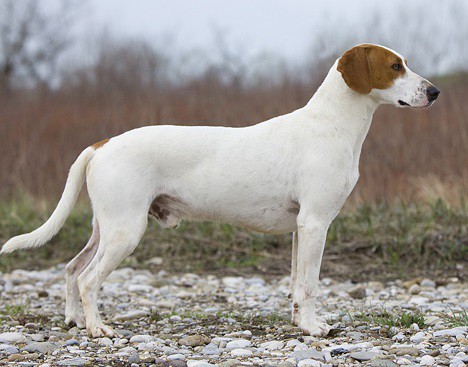Type the name of the breed you're looking for below
[wpdreams_ajaxsearchlite] Don't see the breed your're looking for? Click here and let us know!
Breed Characteristics
1 paw - breed exhibits the least amount of this characteristic
5 paws - breed exhibits most amount of this characteristic
Istrian Shorthaired Hound
| Other Names | Istarski Kratkodlaki Gonič, Istrian Short-Haired Scent Hound, Shorthaired Istrian Scenthound |
| Country of Origin | Croatia |
| Weight | 25 - 29.5 lbs. (11 - 18 kg) |
| Height (at withers) | 17.5 - 22 in. (44 - 56 cm) |
| Coat | Short, smooth and glossy hard coat |
| Colour | Snow white with orange or orange-speckled ears and lemon/ orange markings. |
| Litter Size | 1 - 4 average of 2 |
| Life Span | 11 - 13 years |
| Origin & History | There is no actual proof of great antiquity for today's breed (such as written lineages going back to antiquity), although there is much fanciful conjecture. The type is very old, and the modern breed resembles images seen in frescoes as early as 1497. Writers cited as having mentioned the type include Bishop of Đakovo Petar Bakić in 1719 and the veterinarian Franjo Bertić, also of Đakovo, in 1859. The old type is seen in the Posavaz Hound and the Istrian Coarsehaired Hound as well. The smooth and coarse-haired hounds were used for hunting in Istria (see the article on Motovun for photographs of the sort of mountainous terrain they were bred to hunt) while the Posavaz Hound is from the Sava Valley. The Istrian hounds are thought to be the oldest of the hound breeds in the Balkan region. A stud book was established in 1924 to document which hounds were considered of this breed. The FCI accepted the breed in 1949, but it was not until 1973 that the first breed standard was published (the FCI does not write the breed standard, it is written in the breed's country of origin and published by the FCI to be used internationally, so that other countries will also describe the breed in the same manner as the breed's home country, and not change it to suit themselves.) It is recognised in the scenthound group 6. It is also recognised in the scenthound group in North America by the United Kennel Club. It also is recognised under its original name, the standard English translations, other translations or combinations of the translation and Croatian name by minor kennel clubs and other organisations. It also may be promoted as a rare breed for those seeking an unusual pet. |
| Personality | The ideal temperament according to the standard is docile and calm, and lively and enthusiastic when hunting. |
Care Requirements
| Health | No specific health problems or claims of extraordinary health have been documented for this breed. |
| Grooming | They do not require a large amount of grooming. Their smooth short-haired coat is easy to look after. Owners will simply want to make sure the coat is brushed on a consistent basis. These dogs should only be given baths when they need it. A wipe down with a damp towel should suffice for the bathing aspect, (although you should bathe it with mild soap only if or when necessary; you should also dry shampoo it occasionally), however a rubber, wire, or hard bristled brush would work best for the brushing aspect. The shedding patterns of these dogs are not known. Be sure to check the ears carefully for signs of infection. Their nails should also be trimmed, (particularly to avoid nail-born infections). |
| Exercise | Energetic and possessing great stamina, the Istrian Shorthaired Hound needs plenty of exercise, including a brisk daily walk. It should have a fenced yard of reasonable size in which to romp. |
| Other Considerations | While it can live in an apartment, it may perform better in a small yard. It is important for owners to make sure this dog is never unleashed in an unsecured area, as it may run off in the direction of the first interesting scent it picks up. It is important for owners to make sure these dogs are given lots of space to move around in. The Istrian Shorthaired Hound is still kept in its homeland and in nearby areas for hunting, not as a pet, and is especially valued for hunting fox and rabbit. |



